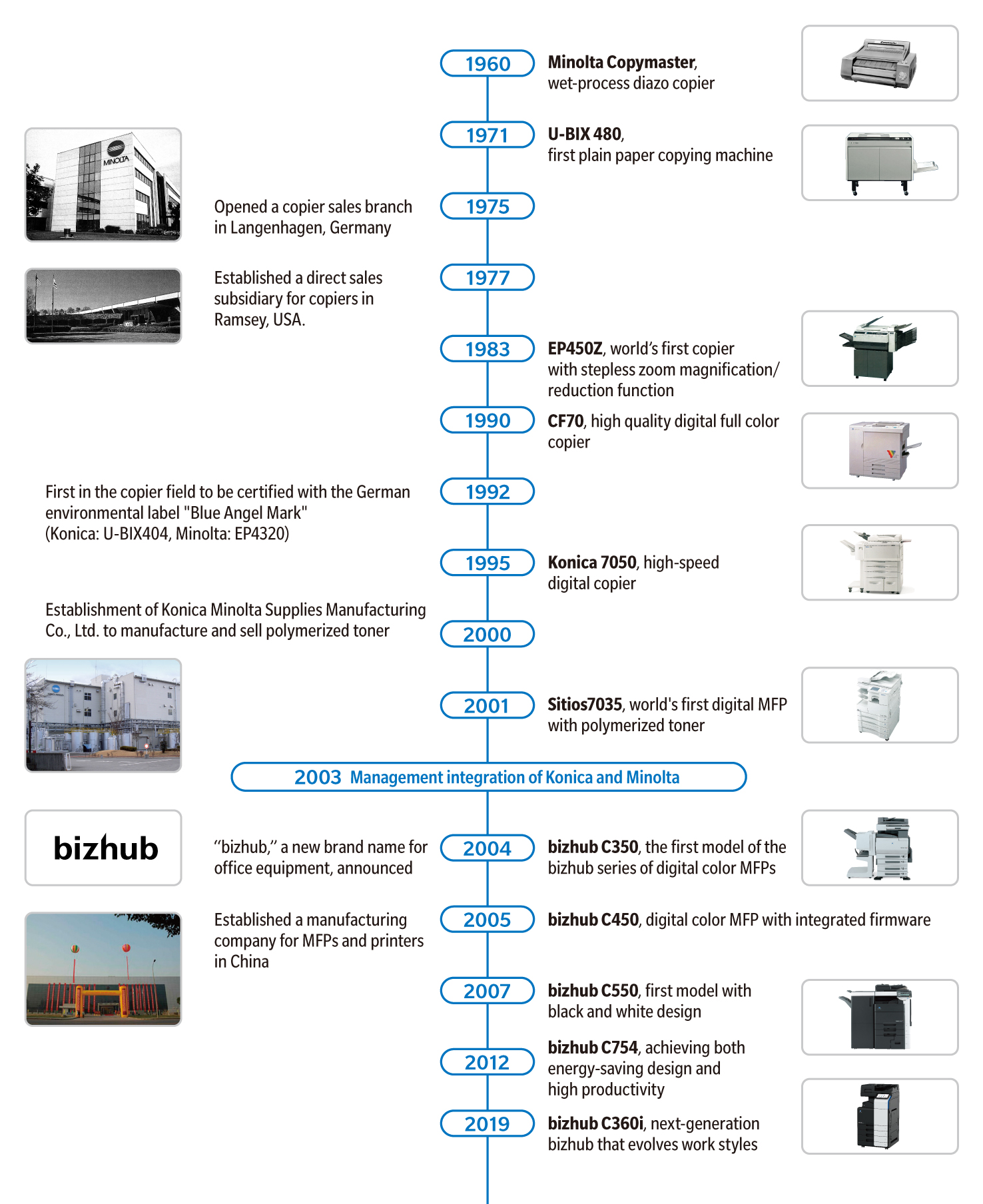INNOVATION STORIES
office business
MFPs Used in All Workplaces
around the World
The History of the Core Business That Led to the Management Integration
- INDEX
Multi-functional peripherals (MFPs) are essential in office work. In addition to their copier, printer, and fax functions, MFPs are also useful for document management by using the scanner as an input device. Today, MFPs are used in all types of workplace, including companies, organizations, and government and public offices around the world. MFPs are probably the most familiar products in our lineup and have the largest number of users.
Regarding the history of our Office Business, the management integration between Konica and Minolta in 2003 was a milestone that was driven by copiers and MFPs. This business faced the biggest challenge in the integration process, since the Office Business was the core for both companies, which were fierce rivals in sales. Employees in respective countries made utmost effort to overcome the difficulties, enabling the company to survive turbulent times after the integration.
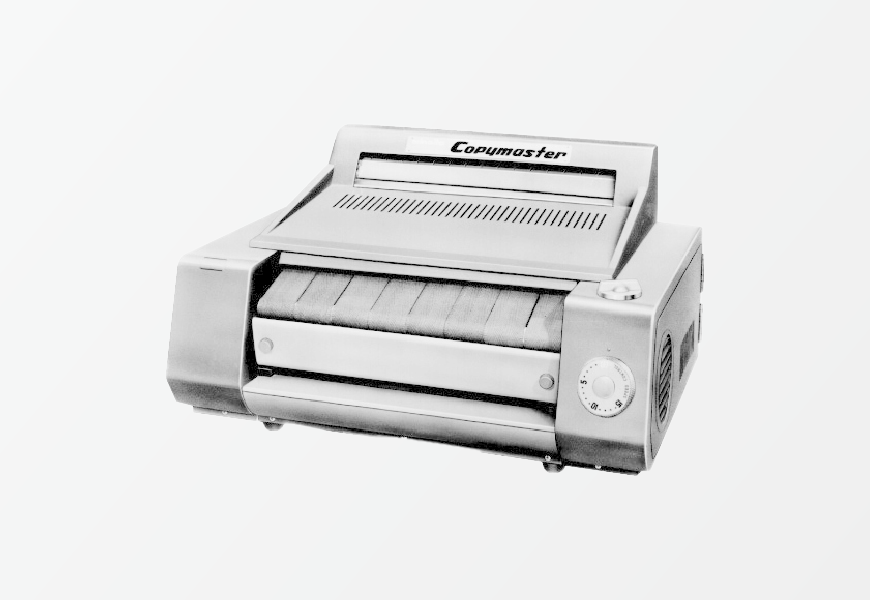
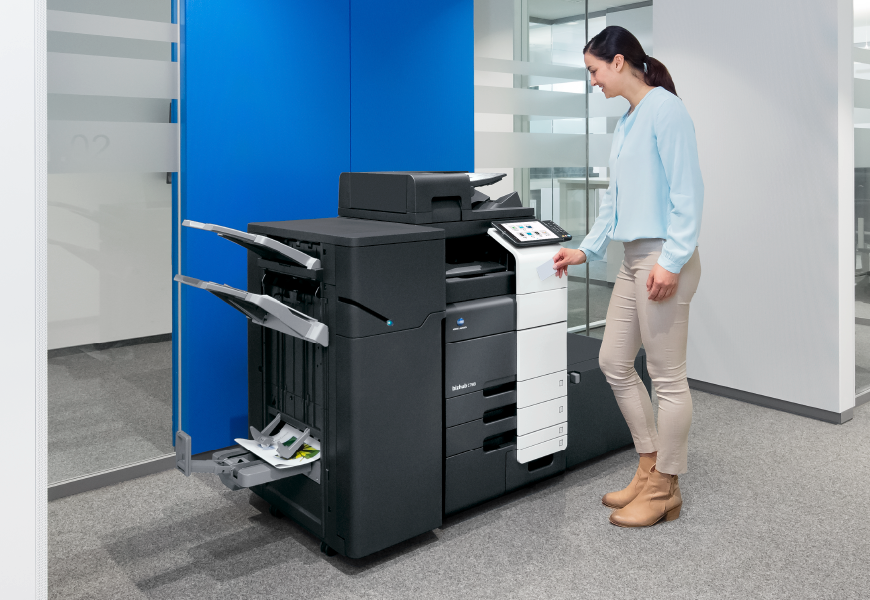
Integration, the only solution to truly harness the strengths
In the late 1950s, 50 years before the integration, Konica and Minolta independently started to develop copiers to take advantage of their optical and imaging technologies refined in the manufacture of cameras. The initial products were designed to print on photosensitive paper, but the goal was to develop copiers able to print on plain paper. After solving the patent issues that were hindering development, Konica released the U-BIX 480 in 1971. Achieving high image quality and low copying cost, this standard model was so popular that production could not keep pace with demand.
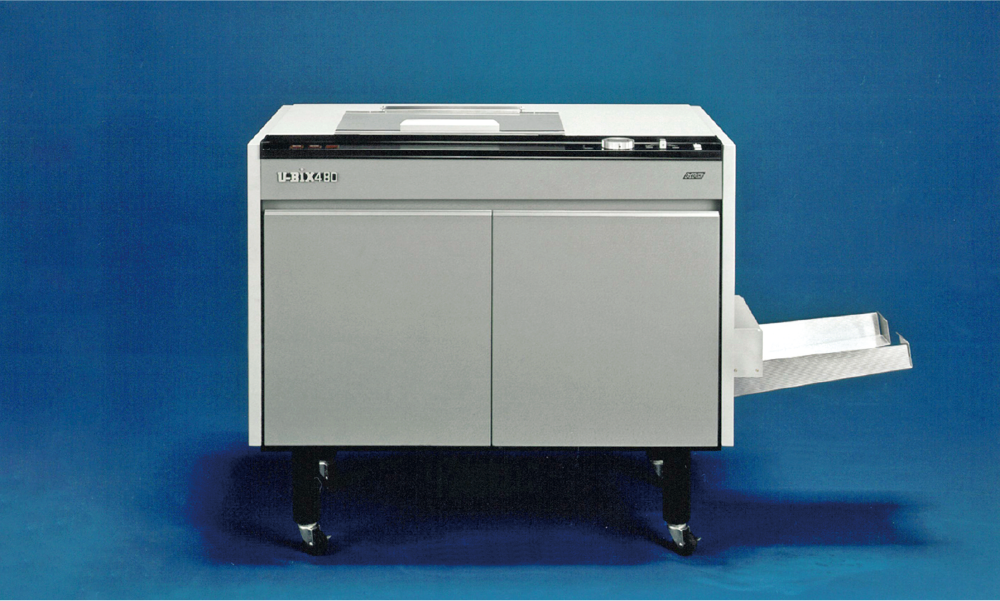
Global demand for copiers grew as computers spread throughout offices. At first, copiers were exported to the European and U.S. markets via trading companies. Subsequently, the two companies started to establish overseas subsidiaries in major countries, leading to the expansion of overseas sales.
Epoch-making products were also developed. The EP450Z, which was released by Minolta in 1983, featured the world’s first zoom function that allowed the magnification/reduction ratio to be changed. It became a hit product worldwide. In 1990, the CF70, the first digital full-color copier, was released, marking the first step of the subsequent color MFP business. Copiers, which were previously standalone products, started to be connected to the network. Later, they evolved into MFPs featuring scanner and fax functions.
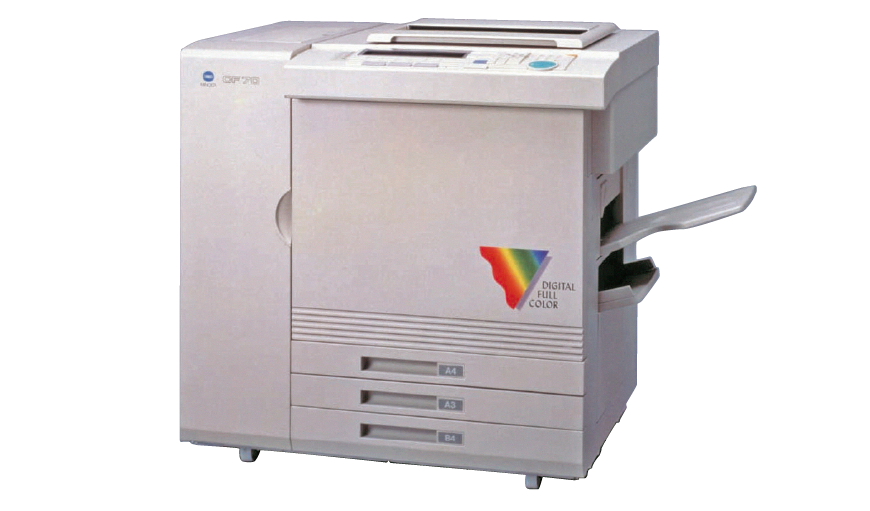
Meanwhile, Konica released the Konica 7050 digital copier in 1995, a general-purpose product that boasted the world’s fastest copying speed of 50 pages per minute, and then continued to release a succession of high-speed copiers. The company also developed polymerized toner, which produces high image quality because of the uniform shape and small particle size compared to conventional pulverized toner, by harnessing its chemical technologies refined in the manufacture of films. Since toner performance directly determines the quality of MFPs, polymerized toner was an important factor in the integration of the two companies.

Before the integration, Konica and Minolta were ranked fifth or sixth by share of the global copier market, lagging far behind the top three. To increase competitiveness, they formed a technical tie-up in office equipment in 2000. Fortunately, their respective strengths were complementary: while Konica excelled in high speed, monochrome, and high durability, Minolta had an advantage in compactness and color. Development and production efficiency could be improved and the lineup expanded by combining strengths and sharing products. Regarding the toner, Konica Minolta Supplies Manufacturing Co., Ltd. was established as a production company through joint investment and started mass-producing polymerized toner.
However, the two companies were still rivals in sales. The technical tie-up alone had a limited impact, and so the top management of the two companies judged that management integration was required to make a breakthrough. On January 7, 2003, Konica and Minolta announced the management integration, with the plan to establish a holding company in August and reorganize the businesses of the two companies in October to launch six business companies. The division responsible for manufacturing and selling copiers was spun off as an business company named Konica Minolta Business Technologies, Inc. (“BT”).
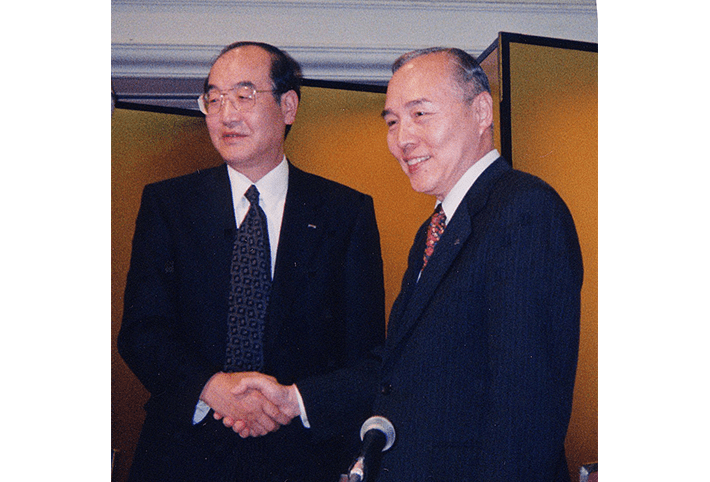
The genre-top strategy was one of the company-wide policies for integration. It aimed to focus managerial resources on specific markets or business domains and become the top brand in those markets or domains. BT targeted high-speed MFPs for the light production printing market and color MFPs as fields where it could demonstrate its strengths. In those days, color MFPs were used only in certain types of business, such as design offices, but BT anticipated that color MFPs would be increasingly used in general offices.
* The office equipment domain is now called the Digital Workplace Business, and the light production printing domain the Professional Print Business.
Struggle by the sales divisions made worthwhile by the commercial value of products
Just after the new year of 2003, the sales divisions in respective countries were shocked by the news of the management integration. In fact, a scoop by a newspaper company in Japan preceded the official announcement. An agonizing, daunting task awaited immediately after the official announcement: the reorganization of the sales divisions of the two companies, which had competed fiercely as rivals. Two sales companies were not necessary in one country or city, and the reorganization was not just our problem.

In the sales of office equipment, a direct sales system had been built by establishing overseas subsidiaries in countries with large markets. However, in many countries, sales had been handled by agencies; in some countries, agencies had been granted the exclusive right to sell Konica or Minolta products, so mutual trust had been built with these agencies over many years. How should the reorganization proceed? The integration aimed to realize a “1 + 1 = 3” effect, but there was a risk of “1 + 1 = 1”.
Notably, the reorganization required backbreaking efforts for the European regional headquarters, which covered about 60 countries, including African countries and some in the Middle East in addition to Europe. It was necessary to hold patient negotiations in many countries with differing situations, and find solutions one by one. Some employees wondered what was the use of an integration that was such an ordeal, but the commercial value of new products instilled a sense of unity.
In February 2004, BT announced “bizhub” as a new product brand for office equipment that symbolized the new Konica Minolta. The coined term, combining “biz” for “business” with “hub” meaning a center or core, means “putting customers at the center of business.” The bizhub C350 (color: 22 ppm, monochrome: 35 ppm), the first product under the brand, sold so well that there was soon a backlog of orders for almost one year thanks partly to the expectations for the new company.

In April 2005 (February in Japan), the bizhub C450 (color: 35 ppm, monochrome: 45 ppm) was released, a much-awaited product developed after the integration. Full-scale development of this model started immediately after the integration, and aimed to attain the challenging goals of the world’s best image quality and reliability at a reasonable price affordable for general offices. It was so difficult to develop the integrated control system, which used the technologies of the two companies, that developers had to stay at the company dormitory, almost like a training camp, for some time. However, the bizhub C450 turned out to be a true symbol of the integration, overcoming the barrier of the development cultures of the two companies. The product, which was completed after such a complex process, was highly evaluated. Sales surged in the U.S. where customers demanded high-speed MFPs, while the bizhub C250 (both color and monochrome: 25 ppm), which was released in July 2005, sold strongly in Europe.
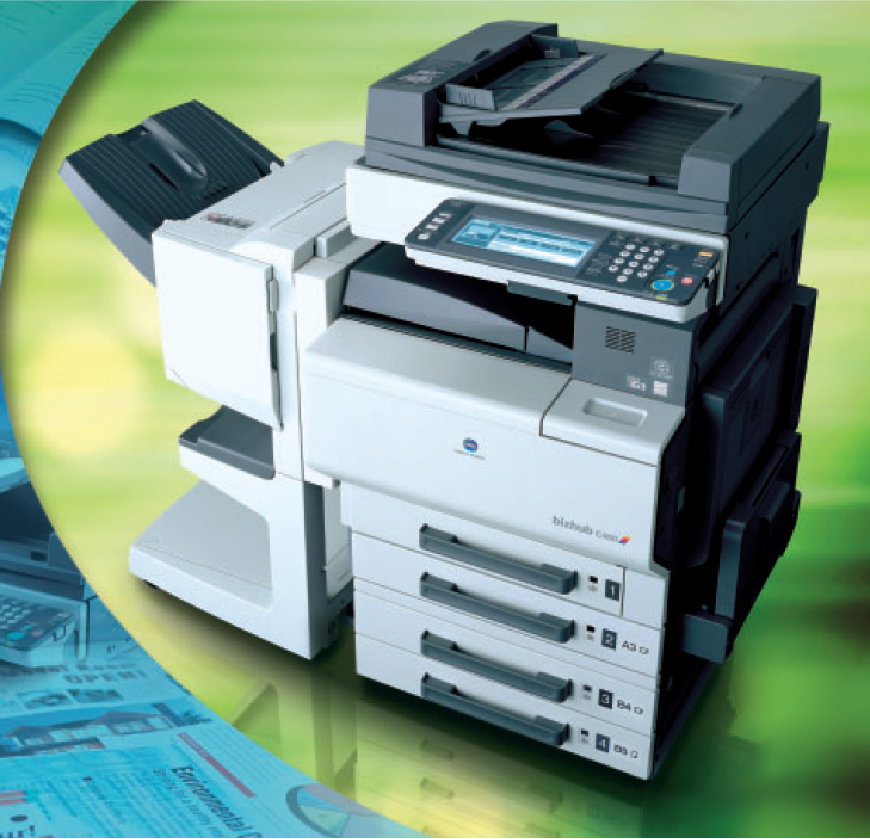
In 2007, a product with a novel design was released: the bizhub C550 (color: 45 ppm, monochrome: 55 ppm) with a stylish black-and-white body. Aiming for installation at the center of an office, the product was designed with an elegant back side. Thanks to its high productivity and high image quality, the device became so popular that it was ordered based solely on the model name together with other models of the series.
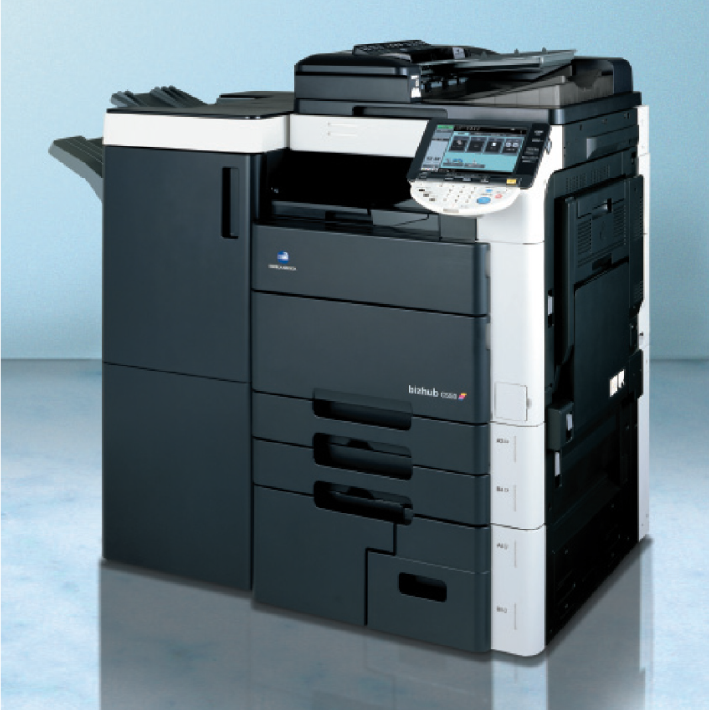
The successful development of this highly competitive product while overcoming difficulties generated a sense of unity of the entire business. The ratio of color MFPs in the market increased significantly, and both revenues and profits of the Office Business continued to increase, with a record-high profit in FY2007.
Later, Konica Minolta continued to pursue the genre-top strategy despite headwinds, such as the Lehman Shock and the Covid-19 pandemic. As of 2023, the company is ranked first or second by market share for A3 color MFPs in about 40 countries, mainly in Europe. It also leads the market for color MFPs in emerging countries where demand is expected to expand. The Office Business remains important because it accounts for just over 50% of revenues. It also helps grow new businesses by underpinning the business foundation and generating steady profits.
Ties with customers, the most valuable asset
MFPs bring together various technologies, including optics, mechatronics, image processing, and chemistry. However, the situation is different from 20 years ago when the two companies were integrated. Today, it is difficult to differentiate in technology. There has been a shift from product leadership, which aims to attain the lead in terms of revenue based on product functionality, to customer intimacy, which strengthens relationships with customers.
The most valuable assets of the Office Business are the direct ties with an array of global customers. MFPs are used by all companies and organizations around the world, with the number of customers far exceeding those of other business units. We can visit customers who use MFPs and directly communicate with them, which leads to new business opportunities. For example, we offered solutions to improve the workflow of broader operations at a medical institution based on issues identified when providing support for MFPs. In another example, a space design business encompassing office layout planning, design, and construction was launched in response to the trend toward working from home and changes in workstyles due to the Covid-19 pandemic, which lasted nearly three years from 2020.

The Office Business, which started from copiers, has been transformed into a solutions business that contributes to solving issues and optimizing the office environment in combination with digital MFPs and other IT services. We squarely tackle the issues of global customers and pursue new possibilities as their reliable partner.

In the interest of clarity, “Konica” and “Minolta,”—the trade names that were used before the merger that formed “Konica Minolta”—are used throughout this text. Each company underwent a number of name changes throughout their history.
